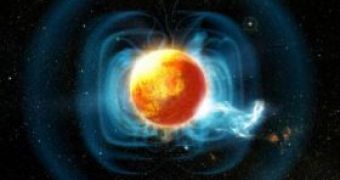Classified as a M-type dwarf star, TVLM513-46546 is an ultracool low-mass star, situated in the Bo�tes constellation, about 35 light years away from Earth. During a simultaneous observation, made with four ground based telescopes, aided by space telescopes, astrophysicists have observed unusual magnetic activity, that cannot be yet explained.
A team of astronomers from Princeton University, led by Dr. Edo Berger, is now studying the observations made on the white dwarf, in the hope that they will be able to explain the strange behavior. The observations made, using the Gemini North 8-meter telescope [ADMARK1] operating in the radio frequencies, the Swift satellite and Chandra in order to take images in the ultraviolet, and the x-ray domain respectively, are part of a unique program of studying the smallest stars in the visible universe, which also includes the study of their magnetic fields, especially of those originating in ultracool small stars that are usually extremely quiet and simple, unlike those seen in their massive cousins.
However, while observing TVLM513-46546 magnetic field, astronomers were shocked to find a unique complex magnetic field. During the collisions and the merging of the magnetic field in the corona, extreme amounts of energy from the annihilation of the magnetic field have produced minute-long flares that have temporarily interrupted the radio emissions from the star. The consequences of these catastrophic collisions can also be observed in the images taken in x-ray, as soft as x-ray flares.
With the help of these observations, astronomers have been able, for the first time, to map the hydrogen-alpha emission for a period of two hours, which matches exactly the spin rotation period of the star. The hydrogen-alpha chart reveals that the star has half of its surface covered by a hot spot, which is similar to that of the surface of regular stars and rotates from our point of view.
Astronomers believe that the star's magnetic field can be described as a simple dipole, similar to that of the Earth, extending into space at least one solar radius above its surface, with random small-scale magnetic fields looping on its surface, similar to those observed on the Sun. This is the spot from which the flares originate; however, the magnetic field is not disturbed by such an activity.
For a star that is barely functional, this complex magnetic activity and the giant hot spot on its surface could be evidence of unusual activity under its surface, where the magnetic field is generated; it is also possible that an unobserved companion is altering its magnetic field.
The M-type star category, from which TVLM513-46546 is part of, represents the stars that have a surface temperature which averages about 2400 Kelvin, with a mass of about 10 percent that of the Sun, whereas our Sun is a G-type star, averaging a surface temperature of 6000 Kelvin.
In stars similar to our own, the interior is disposed in layers, and the heat originating from the core is transported towards the surface in large spinning currents, powered by magnetic field structure. However, coll stars like TVLM513-46546 have a heat transportation system, which is fully convective; thus, the convective zone expands from the core all the way to the surface. Similar stars usually have a very basic magnetic field, such as the Earth's.
In order to find a justification for the strange magnetic field exhibited by TVLM513-46546, scientists expect to study a larger sample of the white dwarf. This weird magnetic field might be a characteristic for all ultracool dwarfs, but until further studies are made, the idea will mostly remain speculative.

 14 DAY TRIAL //
14 DAY TRIAL //